Fear & Greed Index: What It Is and How It Works?


Investing evokes intense emotions. Our feelings about the markets fluctuate drastically, shifting between optimism and dread. This pendulum swings between euphoria and anxiety is known as the investor sentiment cycle. Learning to recognise its patterns is vital for investment success. This is where the Fear and Greed Index comes in.
The Fear and Greed Index, also called the Market Mood Index, aims to quantify investor emotion. It assigns a numerical score representing the sentiment driving markets at any moment. The index ranges from 0 to 100. Low values signify extreme fear, while high values indicate unchecked greed. Identifying current sentiment provides insight into market psychology crucial for informed investment decisions.
- Table of contents
- What Is the fear & greed Index?
- Key elements of the fear & greed index
- How does the fear & greed index function?
- Benefits of using the fear & greed index
- Limitations of the fear & greed index
- The Fear and Greed Index Indicators
What Is the fear & greed Index?
The Fear and Greed Index measures the relative levels of two opposing emotions - fear and greed - among stock market investors at a given time. It aims to quantify investor sentiment numerically on a scale from 0 to 100.
The index was created in the early 2000s by analysts to gauge the influence of psychology on investor decisions and stock prices. It is calculated daily based on a combination of technical and survey inputs.
Key elements of the fear & greed index
The Fear and Greed Index incorporates two categories of metrics in its calculation.
Price-based metrics analyse technical stock market data to assess investor sentiment. They include -
- Price momentum
- Number of stocks hitting 52-week highs vs. lows
- Proportion of stocks advancing vs. declining
- Put and call options volume
- Market volatility
How does the fear & greed index function?
The Fear and Greed Index algorithm analyses the metrics input each day to generate a score from 0 to 100 reflecting market sentiment. The calculation gives no single indicator disproportionate weight.
Scores below 20 indicate extreme fear. Readings above 80 signify extreme greed. The 40 to 60 range reflects neutral sentiment. Comparing the latest readings to past values provides context for assessing current investor psychology.
Some details on how the calculation works.
- Price-based metrics are scored based on their relationship to sentiment, then normalised to a 0 to 100 scale. For example, high volatility signals greater fear.
- Survey-based metrics directly provide sentiment readings on a 0 to 100 scale. For example, the investor survey may ask respondents to rate sentiment on a 1 to 7 scale.
- The final index reading is a weighted average of the normalised price metric scores and raw survey scores.
The index aim is not to predict markets, but rather measure the current level of fear and greed they reflect. Tracking its daily values allows investors to gauge extremes in market psychology.
Read Also: Fear and Greed in Investment: Its Impact on Risk Management
Benefits of using the fear & greed index
The Fear and Greed Index provides investors two main benefits.
- Identifying sentiment extremes - Readings below 20 or above 80 often indicate a divergence between investor emotion and market fundamentals. Recognising when panic or euphoria detach from fundamentals provides potential investment opportunities.
- Contextualising markets - Seeing where current readings fall relative to past values offers perspective on market behavior. A reading of 45 may feel quite fearful in a bull market but neutral after a correction. Understanding relative sentiment helps investment decisions.
The index allows assessing markets objectively, beyond simply reacting to them. This helps investors avoid buying when greed pushes markets too high or panicking when temporary fear drives prices too low. Used prudently, it promotes disciplined investing anchored in data rather than emotion.
Limitations of the fear & greed index
While beneficial, the Fear and Greed Index does have some limitations to consider.
- Not a precise market timing tool - it identifies sentiment extremes but does not pinpoint reversals.
- Reflects current sentiment only; does not predict future performance.
- Some input data availability constraints exist.
- Works best alongside fundamental, technical, and macroeconomic indicators, not as a standalone tool.
The index does not indicate precisely when to buy or sell. But used with other analysis, it provides valuable input for investment decisions. Understanding both the pros and cons allows maximising its utility.
The Fear and Greed Index Indicators
The index ranges from 0 to 100, where 0 signals extreme fear and 100 indicates extreme greed.
Here’s how the sentiment is classified:
0 to 24: Extreme fear
Investors are highly apprehensive, which may lead to selling pressure. This could be driven by factors such as economic uncertainty, geopolitical risks, or major market corrections.
25 to 44: Fear
Investors remain cautious but not as intensely as in extreme fear conditions. This sentiment often results in a more conservative investment approach.
45 to 55: Neutral
Sentiment is balanced, with neither excessive fear nor greed. The market could experience relatively stable phases during this period.
56 to 75: Greed
Optimism among investors increases, potentially driving higher buying activity. In India, this could be fueled by strong economic growth, positive corporate earnings, or favorable policy developments.
76 to 100: Extreme greed
Excessive optimism prevails, which could lead to market bubbles. Caution is necessary in this phase, as corrections may be sharp.
Read Also: Market Mood Index (MMI): Meaning, Advantages and Zones
Conclusion
The Fear and Greed Index delivers an unbiased, quantified measure of investor sentiment. Monitoring its ups and downs aids long-term investment success. It should complement evaluation of fundamentals, technicals, and macro trends for a complete perspective.
While just one tool among many, understanding the cycle between fear and greed is key for investing wisely. Utilising the Fear and Greed Index moves investors closer to mastering emotional cycles and investing with conviction.
FAQs:
What is the idea of fear and greed?
Fear and greed come from the emotional pendulum that drives market volatility. Greed is the feeling of confidence and euphoria in rising markets, while fear is uncertainty and panic in falling markets.
What are the advantages of the fear and greed index?
Some of the main advantages are recognizing extremes in investor sentiment or emotion and putting current market psychology relative to past periods. This can help you avoid buying when greed is high or panicking when fear becomes detached from reality or fundamentals.
What are the 7 indicators of the fear and greed index?
The 7 indicators are: 1) Market momentum, 2) Stock price strength, 3) Stock price breadth, 4) Put and call options, 5) Demand for junk bonds, 6) Market volatility, 7) Demand for safe haven assets.
How is fear and greed computed in the index?
It combines price metrics that have a relationship to sentiment and survey metrics directly measuring sentiment. The final 0 to 100 score is a weighted average of the normalized price metrics and raw survey scores.
What information is provided by the fear and greed index?
It provides you with a number from 0 (extreme fear) to 100 (extreme greed) to gauge investor emotions. The extremes suggest that prices have diverged from fundamentals because of a high degree of optimism or pessimism. Understanding these extremes can aid a trader in identifying opportunities and help them avoid reacting to temporary cycles driven by fear and greed.
Related Searches:
Mutual Fund investments are subject to market risks, read all scheme related documents carefully.
This document should not be treated as endorsement of the views / opinions or as an investment advice. This document should not be construed as a research report or a recommendation to buy or sell any security. This document is for information purpose only and should not be construed as a promise on minimum returns or safeguard of capital. This document alone is not sufficient and should not be used for the development or implementation of an investment strategy. The recipient should note and understand that the information provided above may not contain all the material aspects relevant for making an investment decision. Investors are advised to consult their own investment advisor before making any investment decision in light of their risk appetite, investment goals and horizon. This information is subject to change without any prior notice.
Mutual Fund investments are subject to market risks, read all scheme related documents carefully.
This document should not be treated as endorsement of the views/opinions or as investment advice. This document should not be construed as a research report or a recommendation to buy or sell any security. This document is for information purpose only and should not be construed as a promise on minimum returns or safeguard of capital. This document alone is not sufficient and should not be used for the development or implementation of an investment strategy. The recipient should note and understand that the information provided above may not contain all the material aspects relevant for making an investment decision. Investors are advised to consult their own investment advisor before making any investment decision in light of their risk appetite, investment goals and horizon. This information is subject to change without any prior notice.
The content herein has been prepared on the basis of publicly available information believed to be reliable. However, Bajaj Finserv Asset Management Ltd. does not guarantee the accuracy of such information, assure its completeness or warrant such information will not be changed. The tax information (if any) in this article is based on prevailing laws at the time of publishing the article and is subject to change. Please consult a tax professional or refer to the latest regulations for up-to-date information.